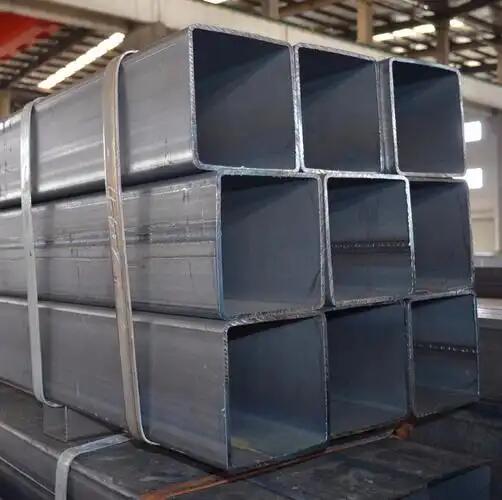What is ERW square tube?
ERW square tube is a square-cross-section steel tube manufactured using the high-frequency
electric resistance welding (ERW) process.
The name itself can be used to explain it:
ERW refers to the production process—high-frequency electric resistance welding.
Square tube refers to its square cross-sectional shape.

ERW Square Tube Manufacturing Process:
The coiled steel strip (steel plate) passes through a series of forming rollers, which gradually bend the straight strip into a nearly round tube. The high-frequency current generates skin and proximity effects, instantly heating the tube edges to a molten state. The tube is then pressure-welded and fused together by squeeze rollers.
A scraper removes excess metal (burrs) extruded from the inside and outside of the weld. The welded tube enters a cooling section and passes through a sizing mill to ensure accurate diameter and roundness. Finally, it passes through a set of specialized dies and is gradually rolled into the desired square or rectangular cross-section.
Key Features of ERW Square Tubes:
1. High Efficiency and Low Cost
The ERW production process is continuous, resulting in extremely high production speeds, far exceeding those of seamless steel pipes. This results in high production efficiency and relatively low costs.
2. High Weld Quality
High-frequency welding results in a narrow heat-affected zone, fine-grained welds, high welding speeds, and minimal oxidation. This results in high weld strength, sometimes even approaching or exceeding the strength of the parent material.
3. High Dimensional Accuracy and a Smooth Surface
ERW square tubes are manufactured from cold-rolled strip steel. Their outer diameter and wall thickness are precisely controlled with tight tolerances. Their surface is free of defects such as scratches commonly found in seamless steel pipes, resulting in a smoother and more aesthetically pleasing appearance.
ERW Square Tube Specification Range:
ERW square tubes come in a wide range of side lengths, covering applications from small precision instruments to large building structures.
Common Square Tube Size Range:
Length: 20 mm × 20 mm to 500 mm × 500 mm.
Wall Thickness: 0.8 mm to 16 mm.
More detailed classifications:
Small tubes: Side length ≤ 80 mm. Commonly used in furniture, decorations, small brackets, etc.
Medium tubes: Side lengths between 80 mm and 200 mm. This is the most widely used range, used in mechanical structures, building trusses, agricultural greenhouses, etc.
Large tubes: Side lengths between 200 mm and 500 mm and above. Primarily used in large building structures (such as main beams and columns in stadiums, airports, and factory buildings), bridges, heavy machinery, etc.
Thin-wall tubes: Wall thickness is typically ≤ 3.0 mm. Mostly used in applications requiring light weight and low load-bearing capacity, such as decorations, furniture, and display racks.
Conventional-wall tubes: Wall thicknesses between 3.0 mm and 8.0 mm. This is the most popular range for structural applications, offering good strength and weight balance.
Thick-wall tubes: Wall thickness > 8.0 mm. Used in critical structural parts bearing heavy loads and high pressures.
Note: In addition to square tubes, the same production process also produces
rectangular tubes, whose dimensions are expressed as length × width, for example, 100mm × 50mm.
Common Standards:
ASTM A500: Primarily used in American standard projects, it is the commonly used structural tube standard in North America.
EN 10219: Applicable to European standard projects.
GB/T 6728-2017: Applicable to Chinese standard projects.
JIS G 3466: Applicable to Japanese standard projects.
Differences from Seamless Steel Pipe:
Seamless steel pipe: Has no welds and is made by perforating round steel. Theoretically, it has better pressure uniformity and is suitable for higher pressure applications, but it also comes at a higher cost.
ERW welded pipe: Has a longitudinal weld seam. In most structural and low- to medium-pressure fluid transportation applications, its performance is fully sufficient to replace seamless steel pipe, offering an outstanding price-performance ratio.
Applications of ERW Square Tube:
Due to its excellent performance and cost advantages, ERW square tube is widely used in the following areas.
1. Building Structures: Steel trusses, columns, and beams are used in factories, high-rise buildings, stadiums, bridges, and other structures, making it a primary material for modern steel structures.
2. Machinery Manufacturing: Used in the manufacture of frames, brackets, bases, and guide rails for various types of machinery and equipment.
3. Automotive Industry: Used in the manufacture of structural components such as chassis frames, bumpers, and drive shafts.
4. Agricultural Greenhouses: Serving as the framework for greenhouses, it offers high strength and corrosion resistance (typically requiring galvanizing).
5. Furniture Decoration: Used in the manufacture of modern tables, chairs, bed frames, and display racks, owing to its aesthetic appeal and strength.
6. Logistics and Warehousing: Used in the manufacture of shelves, storage cages, and logistics conveying equipment.
Conclusion:
ERW square tubes, due to their high efficiency, cost-effectiveness, high dimensional accuracy, and excellent weld quality, have become an indispensable material in numerous fields, particularly the construction and machinery industries. They are a highly effective alternative to seamless steel pipes in many low- and medium-pressure applications.
Read more: ASTM A500 Square Tube or Galvanized Square & Rectangular Tube


